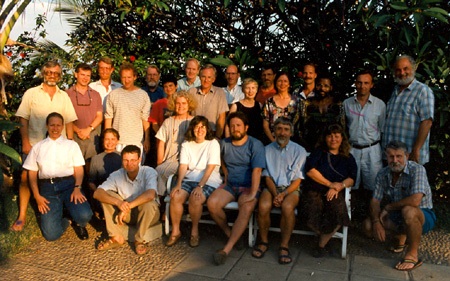African Biogeography, Climate Change, and Early Hominid Evolution
Date
Oct 25 - Nov 2, 1995Organized by
Timothy G. Bromage and Friedemann SchrenkLocation
The Livingstonia Beach Hotel, Salima, MalawiPublications
African Biogeography, Climate Change, & Human Evolution (Timothy G. Bromage and Friedemann Schrenk, Eds.), Oxford University Press, 1999.Participants
- Peter Andrews Natural History Museum, UK
- Brenda R. Benefit Southern Illinois University, USA
- Ray Bernor Howard University, USA
- Laura Bishop University of Liverpool, UK
- Timothy G. Bromage City University of New York, Hunter College, USA
- George H. Denton University of Maine, USA
- Christiane Denys Natural History Museum, France
- Craig Feibel Rutgers University, USA
- Robert A. Foley University of Cambridge, UK
- Peter Grubb National History Museum, UK
- Yusuf M. Juwayeyi Department of Antiquities, Malawi
- Thomas Kaiser City University of New York, Hunter College, USA
- Jeffrey McKee University of the Witwatersrand, South Africa
- Eileen M. O’Brien Institute of Ecology, USA
- R. Norman Owen-Smith University of the Witwatersrand, South Africa
- Fernando Ramirez-Rozzi Musée de l’Homme, France
- Michael L. Rosenzweig University of Arizona, USA
- Friedemann Schrenk Hessian State Museum, Germany
- Nancy Sikes Smithsonian Institution, USA
- Sydel Silverman Wenner-Gren Foundation, USA
- Frederick S. Szalay City University of New York, Hunter College, USA
- Alan Turner University of Liverpool, UK
- Elisabeth S. Vrba Yale University, USA
- Bernard Wood University of Liverpool, UK
ORGANIZER’S STATEMENT: Twenty-three scholars from Africa, Europe, and the United States assembled in Salima, Malawi, with two goals: I) to consider the potential for a paradigm shift in palaeoanthropology away from taxonomic analyses limited to character similarities and differences, toward a paradigm that interprets characters ecologically and adaptively in the larger context of their habitat specificities; and, 2) to explore the means by which such a paradigm might help us to better chronicle human biological and cultural evolution. This perspective implies a certain “ecocentric” view as to the nature of hominid lineages and the way we define their taxonomic segments. Such a perspective is needed at this time to account for the relationship between eastern and southern Africa in hominid evolution, as the more traditional morphological taxonomic approaches have neglected to account for the fact that these areas belong to two seemingly different ecological domains: tropical and temperate zones, respectively.
Among the important questions addressed by the conference were: How can shifts in evolutionary theory influence the practice of taxonomy? What constitutes climate change, and how can the “turnover pulse” of extinctions and speciations resulting from this change be defined? What techniques can be applied to indicate the degreee to which early hominids were ecosensitive, and was this sensitivity affected by a material culture? In what way, ifany, might climate change have precipitated the origins of Hominidae and Australopithecus, megodontia in Paranthropus, and encephalization and tool making in earliest Homo? Can the differences between eastern and southern African hominids be attributed either to geographic variations or to true species differences?
Wenner-Gren Symposium #119
